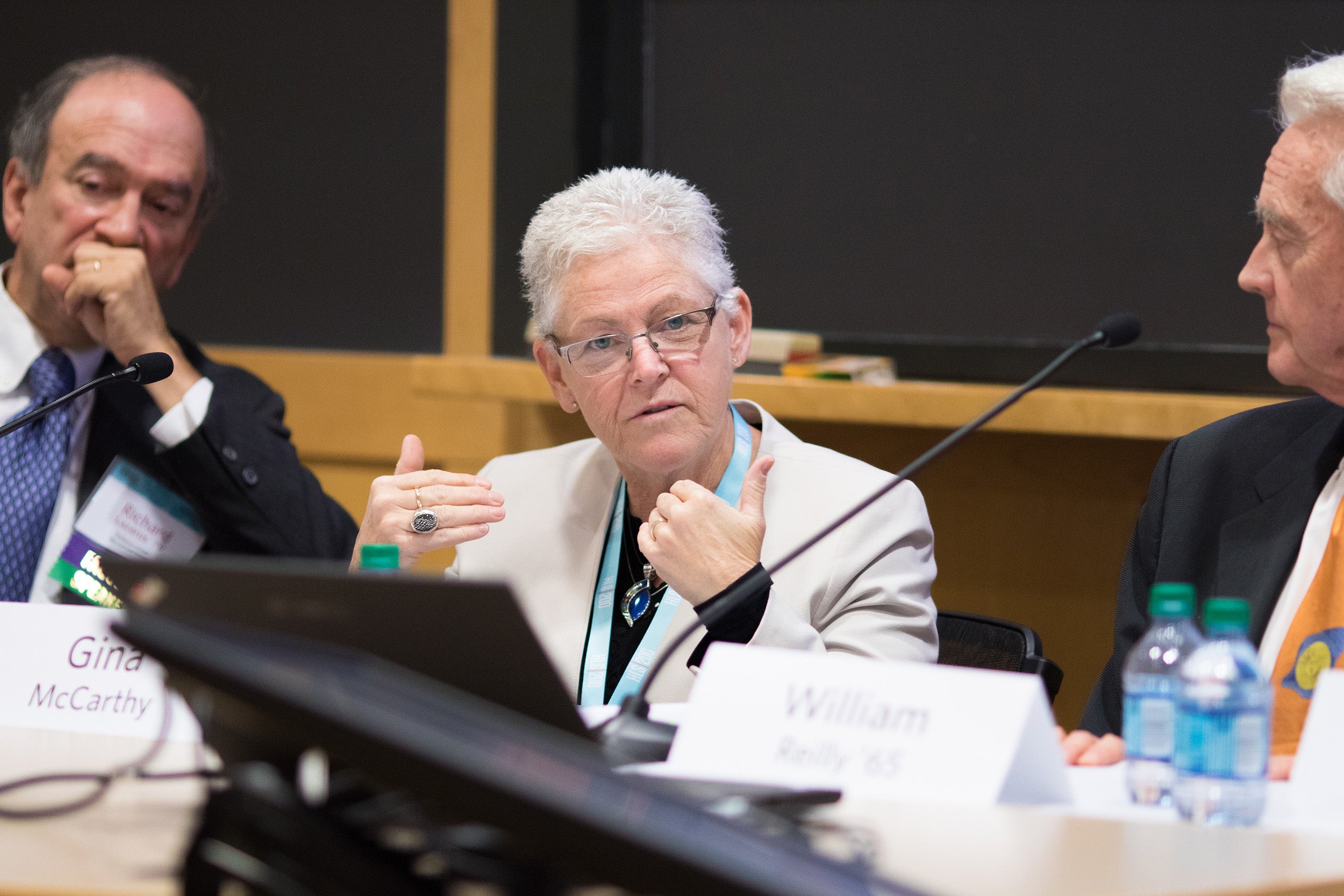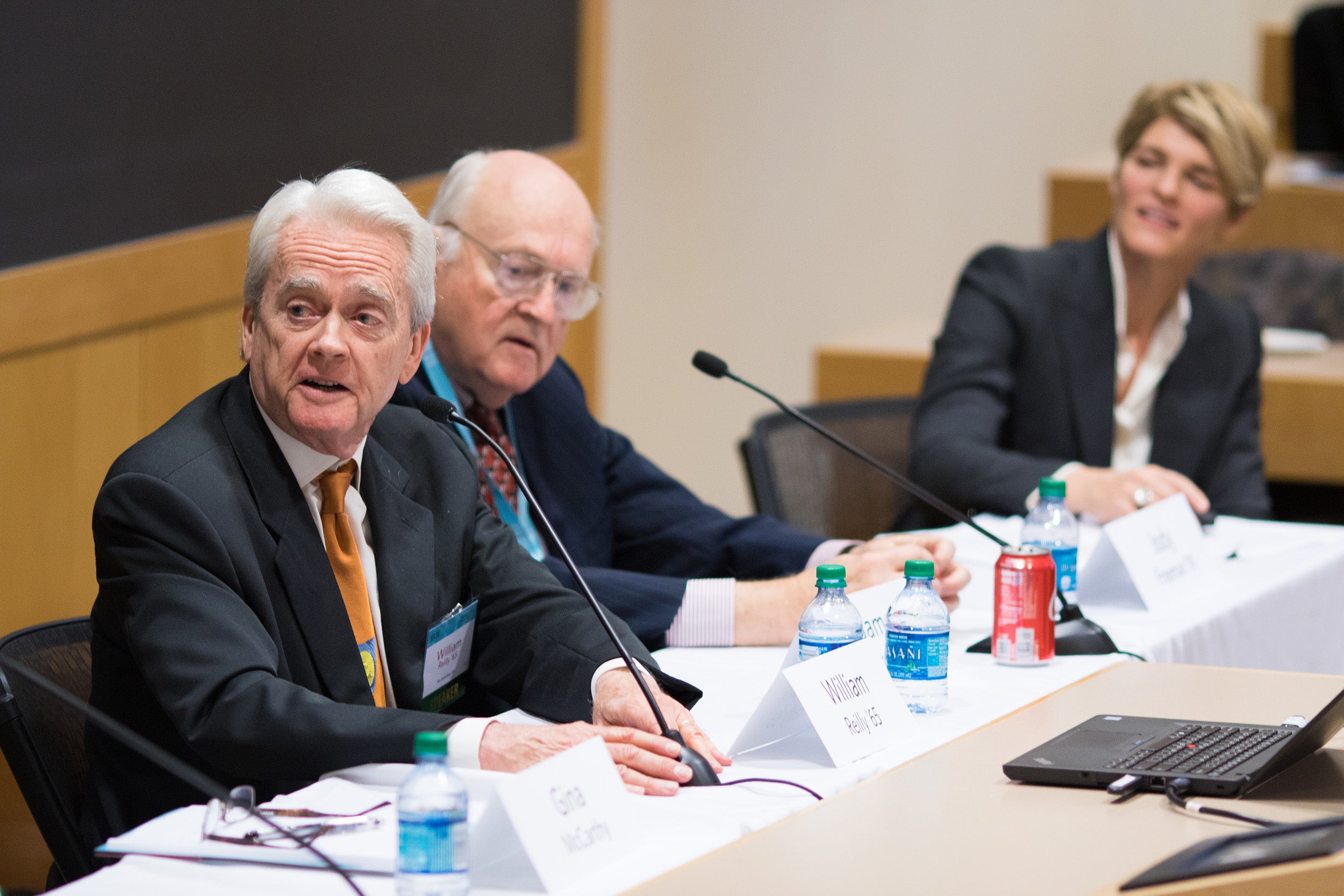There was a noticeable shadow hanging over “The Remarkable Evolution of American Environmental Law from Nixon to Trump and Beyond” panel during Harvard Law School’s bicentennial summit, held at HLS on Oct. 27. The elephant in the room was the uncertain future of the Environmental Protection Agency in the current administration. Panelists A. James Barnes ’67, Richard J. Lazarus ‘79, William Reilly ’65 and Gina McCarthy looked at the EPA’s distinguished history—and at how it might survive.
Faculty moderator Jody Freeman LL.M. ’91, S.J.D. ’95, the founding director of the Harvard Law School Environmental Law and Policy Program, pointed out that the EPA was initially created, and later championed, by Republican administrations, and she bluntly asked what went wrong. The historical background was provided by Barnes, who was chief of staff to the first EPA administrator William Ruckelshaus ’60. As Barnes noted the environmental movement barely existed before 1970, the year of the first Earth Day. The impetus was a string of environmental disasters: The Cuyahoga River catching fire, the Santa Barbara oil spill, the near-death of Lake Erie and the near-extinction of the bald eagle. “People were also beginning to notice that their favorite fishing hole was no longer producing fish,” Barnes said. “There were vast outpourings of public concern, an estimated 20 million people at sit-ins and protests. In 1969 Congress passes an environmental act that Nixon signs, and he proclaims that the 1970s will be the decade of the environment.” The EPA was formally created in late 1970, and soon afterward Barnes took members of the Department of Justice to college campuses, “to convince them we were not Repression Central.”
Nixon wasn’t the only Republican to champion environmental causes. As Lazarus pointed out in his book “The Making of Environmental Law,” one of the short-listed candidates for original EPA head was George H.W. Bush, who was passed over because of his connections with the oil industry. And Lazarus added on Friday that Bush was serious about his aim to be the “the environmental President,” a claim that his Democratic opponents sometimes ridiculed. And that, Lazarus suggested, may have been what tipped the scales: Neither Nixon nor Bush got much political return for their pro-environment stance, leading them to rethink their principles. “Nixon was a strong environmentalist for about 18 months. Then he pivoted away and began feeling he was catering too much to the left—so he starts laying the groundwork for the anti-big government agenda that Reagan ran on.” Bush also ran on the environment, citing the pollution of Boston Harbor —then he also pivoted, since he got so little political credit for it. “But he did appoint Bill Reilly to the EPA, and that was an extraordinary appointment.”

During his time as EPA administrator under Bush, Reilly dealt with the Exxon Valdez oil spill and led the delegation to Rio for climate talks; he later worked with President Obama after the Deep Horizon oil spill in the Gulf. On Friday he agreed with Lazarus’ theory that Bush came in as an environmentalist, but that priorities shifted after Newt Gingrich’s Contract with America. “Most people around Bush thought that being the environmental president was a ploy to get elected, and so he got very little credit for the Clean Air Act. Karl Rove certainly learned from that. In the second two years of his administration, you had Pat Buchanan proposing getting rid of the EPA, and things really changed. I was told by my general counsel that I had to permit additives to gasoline, and I wouldn’t allow it.”
The issue of climate change came to the fore during McCarthy’s tenure as EPA administrator under Obama. And she was frank about the changes in the EPA since then. “It was fine and now it stinks,” she said. “The thing that really bothers me is people saying, ‘I believe in climate change’—It’s not a system of beliefs. It’s getting hung onto a religious premise, and there is a slippery slope when you start moving away from science. We now have a chair of the science committee who thinks that the world was created a few thousand years ago.” Reilly added that he’d found a way to reconcile environmentalism with creationist beliefs: By framing the argument as one of stewardship and taking care of the planet.
Though they worked for different administrations, Reilly and McCarthy agreed that heading the EPA could be a balancing act. “I felt like I was tap dancing every day,” McCarthy said. “We actually had quite an elegant strategy, and everything we did was done with the understanding of what the impact on public health would be.” And Reilly cited accomplishments during his tenure—notably wetlands cleanup and getting the auto industry to reduce carbon dioxide emissions—that were made despite resistance from within the administration. “We had a strong enforcement record, even if it got very difficult with Chaney having veto power. One of my rules was that I tried to never antagonize the oil industry and the auto industry in the same week.”
The panelists agreed that environmental awareness has only increased since the EPA’s founding in 1970—and that is where the hope lies, rather than with any specific administration. “We are seeing a change in state and local governments as the federal government seems to be retreating,” McCarthy said. “The closer you get to human beings, the more difficult it is to deny the challenges they are facing.” During her tenure, she noted, awareness rose that deaths related to environmental causes are more common in among those lower of income. “We now know who is going to get whacked, and young people are understanding this way better than my generation did.”
Reilly recalled a conversation he once had with Margaret Thatcher. “I asked her why the issue of regulation was never so big [in the UK]. She said that it was a small island and that they all learned to get along. Maybe we [in the US] didn’t do that. But on the other hand, many of the major environmental statutes emerged here. So maybe we are doing something right.”
